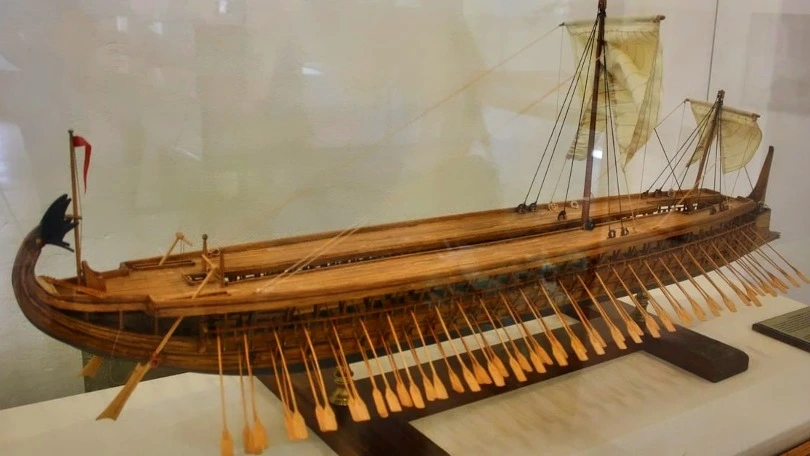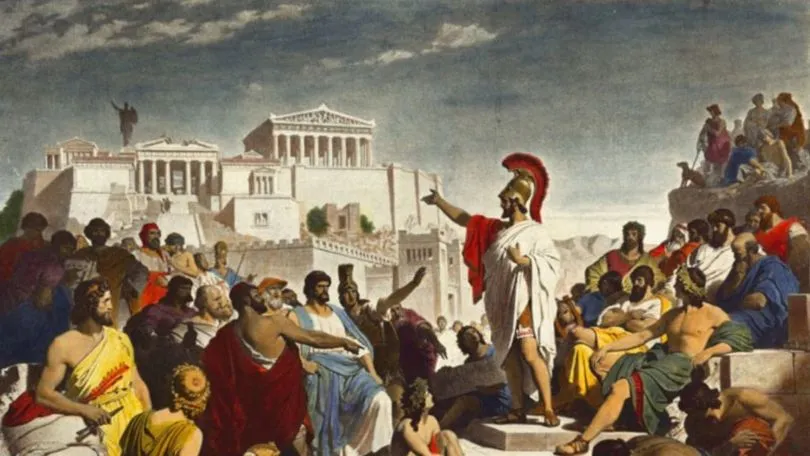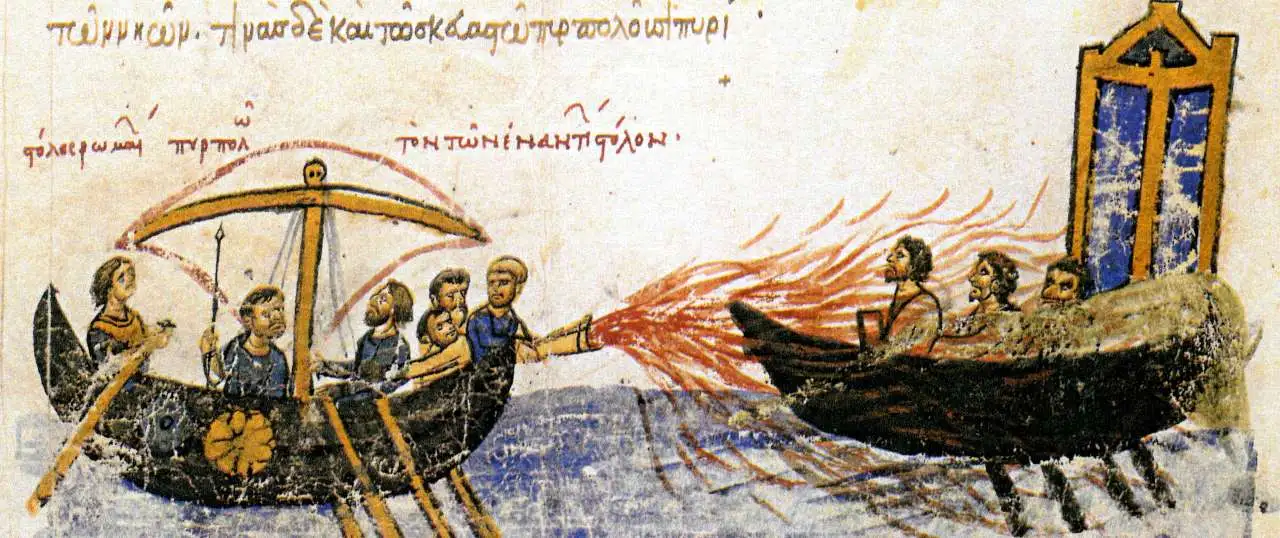Introduction
About 2,500 years ago, Greece was one of the most important places in the ancient world. The Ancient Greeks were great thinkers, warriors, writers, actors, athletes, artists, architects and politicians. But did you know the Ancient Greeks were also responsible for many inventions we still use today?
You may not know how much of the technology we rely on today is thanks to the ancient inventions of Ancient Greece. In this post, I delve into the world of Ancient Greek technology (and one modern day) to see the amazing Greek inventions we still use today
1. Greek Fire

Greek Fire was the secret weapon of the Byzantine Empire, and it was used against enemy ships to completely destroy them. It was a highly flammable jelly-like substance blasted a distance of around 50 feet through tubes made of bronze mounted onto boats. It was also placed in buildings that needed to be protected.
Any attempt to put Greek Fire out with water would be an absolute failure, as water would actually cause the fire to spread and burn more intensely. There is even strong evidence to suggest that Greek Fire continued burning when submerged in water.
Greek Fire was so effective that it was used extensively in wars for centuries. In fact, it wasn’t until the 19th century that a similar invention was created called the flamethrower.
To this day, historians and scientists are unsure of its exact formula. Still, they think it was probably a mixture of liquid petroleum, sulphur, naphtha and quicklime.
2. The Olympic Games

The fascinating thing about the Olympic Games is that they originated in ancient Greece, some 3,000 years ago. It’s incredible to think that this great sporting competition has been around for so long. The Games were held every four years in Olympia in honour of the god Zeus and were a hugely important part of Greek culture.
The first written records of the ancient Olympic Games date back to 776 B.C., when a cook named Coroebus won the only event – a 192-meter footrace called the stade (the origin of the modern word for ‘stadium’). The influence of the ancient Olympic games was so great that ancient historians began to measure time by the four-year increments between Olympic Games, known as Olympiads.
The ancient Olympic Games were open only to freeborn male citizens of Greece. Over time, new events were added to the Games, including the diaulos (a 400-meter race), the dolichos (a long-distance race), and the pentathlon (consisting of five events: a foot race, a long jump, discus and javelin throws, and a wrestling match). In 648 BC, pankration—a (sometimes fatal) combination of boxing and wrestling with virtually no rules—was introduced as an Olympic event. Women were not allowed to participate in the ancient Olympics, and married women were prohibited from attending the competition.
3. The Hippocratic Oath

The Hippocratic Oath is a fascinating set of ethics historically taken by doctors, physicians and surgeons. It is one of the most well-known Greek medical texts. Its original form required people to swear by several healing gods to uphold specific ethical standards.
The oath is the earliest expression of medical ethics in the Western world. It establishes several principles of medical ethics which are still highly relevant today. These include the principles of medical confidentiality and not committing harm or evil.
The oldest partial fragments of the oath date to around AD 275. The oldest extant version dates to roughly the 10th–11th century, held in the Vatican Library.
Although the exact origins of the Hippocratic Oath are debated, it is generally believed to have been written in Ancient Greek between the fifth and third centuries B.C. The oath is traditionally attributed to the Greek doctor Hippocrates and is usually included in the Hippocratic Corpus. However, many modern historians do not believe that Hippocrates himself wrote the oath.
4. The Athenian Trireme

The Athenian trireme was one of the most important inventions of ancient Greece. It was a fast and manoeuvrable warship that was used in battle to significant effect. The trireme was named for its three rows of oars, which allowed it to reach speeds of up to 9 knots.
Excavations of the ship sheds at the main war harbour of ancient Athens have provided a general outline of the Athenian trireme. The sheds that Triremes were held in were around 40 m long and just 6 m wide. This results in an overall ship length of just under 37 m. The height of the sheds’ interior led to estimates that the hull height above the water surface was about 2 metres. Its draught was relatively shallow, about one metre, which allowed it to be beached easily in addition to the relatively flat keel and low weight.
The trireme was used in some of the most famous battles in Greek history, such as the Battle of Salamis and the Battle of Marathon.
5. The Pap Smear

Don’t worry; for the sake of everyone and myself, I won’t go into much detail about the procedure.
The Pap smear is a medical procedure used to detect cervical cancer in women. It was invented by George Nicholas Papanicolaou, an Athens-educated Greek-American doctor.
Papanicolaou’s early research focused on guinea pigs. Still, he soon realized that the reproductive cycles of animals could be timed by studying smears of their vaginal secretions. From 1920 onwards, he turned his attention to humans. He was delighted to find that normal and malignant cervical cells could be distinguished simply by looking at swabs under a microscope.
Although his initial publication on the subject in 1928 went largely unnoticed, Papanicolaou’s work would eventually significantly impact our understanding of human physiology.
6. The Theatre

Who would have thought that the Ancient Greeks would be responsible for inventing theatre, one of our main forms of entertainment today? Without them, we might not have the vast array of options for enjoying a play, musical, or movie. It’s fascinating to think about how different our world would be without this significant contribution from the Greeks.
Theatre is believed to have formally originated in the city-state of Athens. The word “theatre” has its roots in an Ancient Greek word. It is widely thought that the Ancient Athenians had a natural talent for drama that extended into everyday life events such as religious ceremonies, weddings, funerals, and more. Over time, people began creating plays specifically to be performed at theatres. They were written down so that the performance could be repeated. Theatre is also looked at as a form of oral storytelling. Many of the stories that were handed down through the generations were eventually dramatized so that a larger number of people could enjoy them at once.
Though there is much debate among historians, many agree that theatre as we understand it today began at the Great Dionysia, an annual religious festival in Athens. The event was dedicated to Dionysius, the god of wine, and featured performances by playwrights at the Theatre of Dionysius near the Acropolis. This theatre still stands today.
The Ancient Greeks not only invented theatre itself, but they also created multiple genres, including comedy, tragedy, and satire genres. Each of these entertained audiences initially in Athens, and then the practice spread throughout Greece. These plays were performed in the ancient theatres initially built in Athens, and then the other ancient city-states began building them.
The Ancient Greeks indeed invented the theatre as we know it today. Many of the plays written back then have not only survived but are still being performed today, such as Oedipus Rex, Medea, and Prometheus Bound.
7. Democracy

The ancient Greeks were the first to create a democracy. The word “democracy” comes from two Greek words that mean people (demos) and rule (kratos). Democracy is the idea that the citizens of a country should take an active role in the government of their country and manage it directly or through elected representatives. In addition, it supports the idea that the people can replace their government through peaceful transfers of power rather than a violent uprising or revolution. Thus, a key part of democracy is the people’s voice.
Around the fifth century B.C., the city developed a government system based on its citizens’ collective will. This was a radical departure from other forms of government at the time, which were often based on a dictatorial rule or the whims of a single ruler. In Athens, all adult citizens were required to take an active part in the government. If they did not fulfil their duty, they would be fined and sometimes marked with red paint. The Athenian definition of “citizens” also differed from modern-day citizens: only free men were considered citizens in Athens. Women, children, and slaves were not considered citizens and therefore could not vote.
Each year, 500 names were chosen from all the citizens of ancient Athens to serve in the government for one year. This form of government is called direct democracy. During that year, they were responsible for making new laws and controlled all parts of the political process. When a new law was proposed, all the citizens of Athens had the opportunity to vote on it by attending the assembly on the day the vote took place.
8. The Catapult

For as long as history has been recorded, weapons have been needed. Weapons can be used to keep people safe, defend their lands, and wage war. Weapons have evolved over the centuries, and weapons have improved as new technologies have come into the picture. Early weapons such as the catapult are some of the most memorable.
The Ancient Greeks are credited with inventing the stone-throwing catapult. This powerful weapon could hurl stones at enemy forces with increased velocity, inflicting greater damage than if someone simply threw the stone by hand. The Greeks used catapults to break down city walls and inflict more damage on their enemies. Some catapults could even hold stones weighing over 150 kg (330 lbs), much more than a person could lift on their own. With the added weight and velocity of the stones, the catapult gave the Greek armies a significant advantage in battle.
9. Archimedes’ Screw

The Archimedes screw, also known as the Archimedean screw, hydrodynamic screw, water screw or Egyptian screw. It is named after Greek mathematician Archimedes who first described it around 234 BC.
The screw consists of a long, spiral blade inside a hollow pipe that is turned by a handle. As the screw is turned, the blade moves water up the spiral. The water is then discharged at the top of the screw. Archimede’s Screw was used to irrigate crops and to remove water from ships. It was also used to power sawmills and pumps. Today, this invention is still used in some parts of the world.
10. Pythagoras’s Theorem

Do you remember this from school? ” In a right-angled triangle, the square of the hypotenuse is equal to the sum of the squares of the other two sides”. You can thank the ancient Greek philosopher and mathematician Pythagoras for that.
But, did you know this theory is still used today in so many important areas, including:
- Oceanography, to calculate the speed of sound waves in the water.
- Meteorology and aerospace to determine the sound source and its range in space.
- Electronic components such as tv screens, computer screens, and solar panels.
- Navigation to find the shortest distance between two given points.
- Architecture and construction to find the slope of a roof, drainage system, and building.
In conclusion
There you have it, my top ten choices for the most amazing Greek inventions we still use today. It shows just how amazing the Ancient Greeks were as thinkers, writers, actors, mathematicians and inventors.
Thank you for your time.

